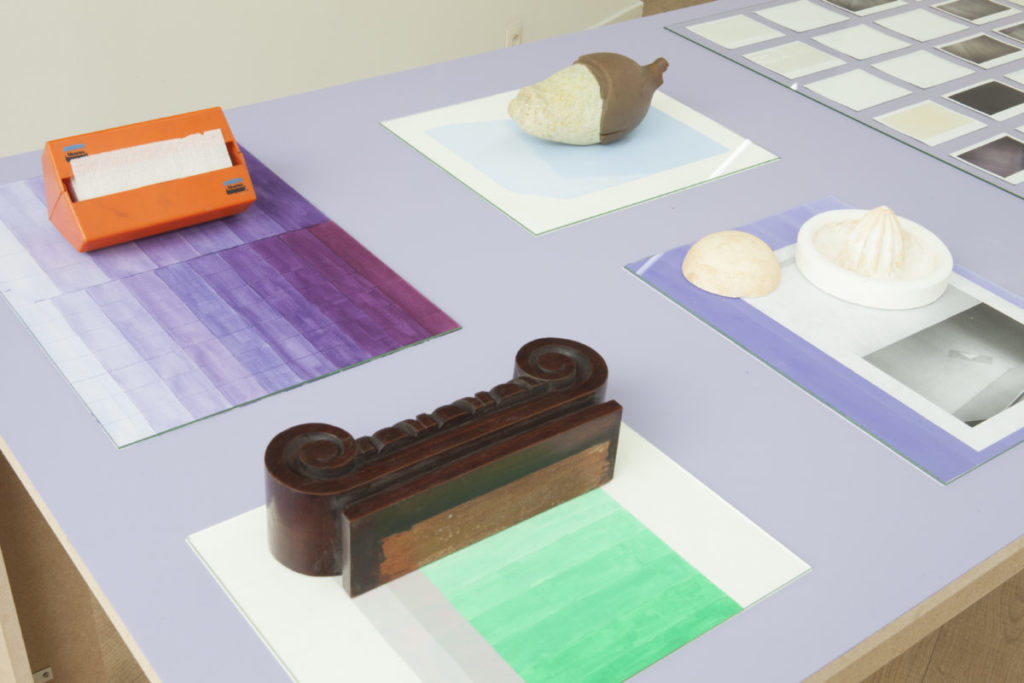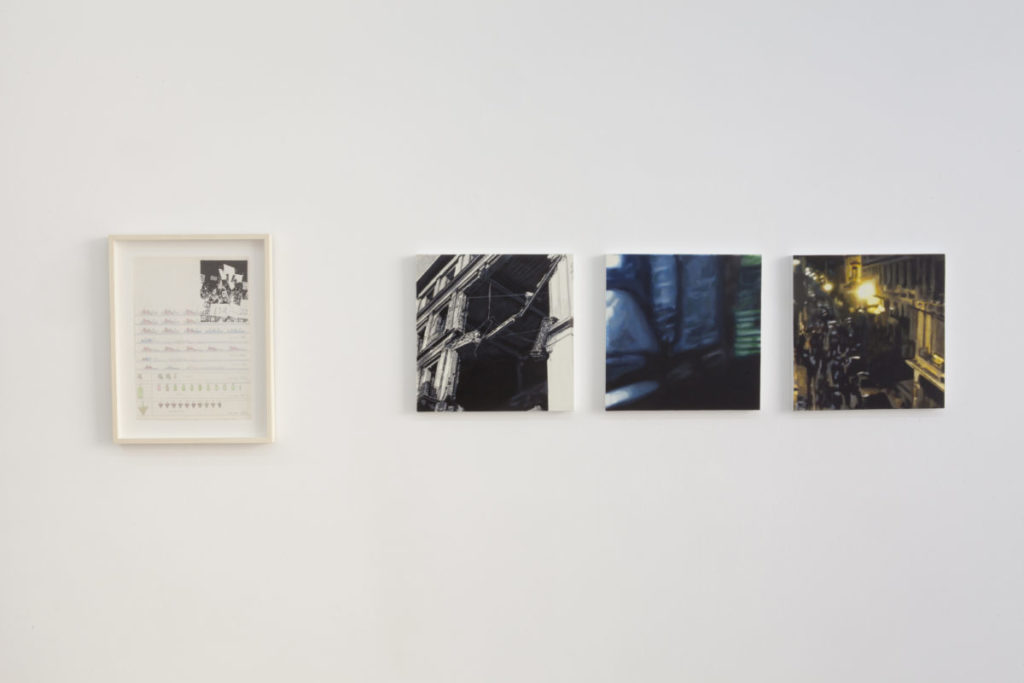FR ///
Comment faire part de ce qui est vu et le transmettre par la facture même de l’image ? C’est dans la capacité à solliciter des micro-événements en marge de l’écriture dominante afin d’en proposer une lecture subjective que le travail d’Eirene Efstathiou et celui Eduardo Matos se rencontrent.
Ralentir et prendre le temps d’observer autour de soi ce qui se passe. L’installation de 2013 « Lamp’s Explanation » qu’Eduardo Matos propose de réactiver incite à cette introspection. Cette recherche a germé dans la solitude de son appartement bruxellois et dans une volonté de résistance vis-à-vis du monde extérieur. Ce à quoi il tente d’échapper s'infiltre pourtant dans son quotidien. Les jeux de lumière de la ville se dessinent sur les murs blancs de son atelier. Eduardo Matos dessine comme il peint. Il recouvre les papiers par une superposition de fines couches de couleurs à l’instar des glacis présents chez les maîtres du XVe siècle. C’est la température et l’éclat de ces lumières le plus souvent artificielles qu’il tente de saisir dans ces deux nouvelles séries de dessins. Parfois, des détails de son appartement sont inclus dans ces tentatives qui relient intérieur et extérieur. Parallélément à ses dessins, Edouardo Matos présente une vidéo qui rejoue, elle aussi, un processus conçu dans le cadre de Lamp Explanation. Une boucle montre l’espace vide de son appartement où s’orchestre une chorégraphie d’objets annonyme. Ils apparaissent et disparaissent au gré du mouvement cyclique de la caméra. L’absence est une notion clé dans les observations intimes que propose l’artiste. Elle interroge ce qui est vu, ce que l’on devrait y voir et la manière dont nous appréhendons ces images tout autant que monde.
En s’intéressant aux protestations de juillet 1965 qui ont eu lieu en amont du coup d’état grecque Les dessins de la série « No. 3 Map trace » (2016) réalisée par Eirene Efstathiou ont davantage une portée de témoignage. Sur les pages d’un ancien atlas pédagogique colorié par des enfants, l’artiste juxtapose photographies d’archives et annotations statistiques d’après-guerre qui décrivent les pertes matérielles sous l'occupation. Ce procédé qui fait s’entrecroiser des valeurs documentaires avec des données subjectives attire l’attention sur le rapport faussé introduit par la société médiatique et le regard qu’elle porte sur les événements. Un dispositif similaire est sollicité dans ses sérigraphies rehaussées de peinture. Dans celles-ci, elle confronte des images datant de 1968 avec celle du même mois en 1944. Il en résulte un flou sémantique dû à la perte de contexte qui permettrait d’interpréter les faits. Ces représentations laissent place à des visions de ruines et d’absence. Le regard d’Eirene Efstathiou toujours porté en périphérie du discours dominant affronte l’impossibilité d'une représentation de la violence et du chaos
«Regarding the continuity of disrupted images » interroge la manière dont circulent les images, le manque de références à leur sujet mais aussi perception que nous en avons. Face à l’incertitude que produit par la surabondance d’informations ne devrions-nous pas ralentir et prendre le temps d’observer autour de nous ce qui se s’y passe ? Que ce soit par le biais d’une problématique singulière ou par les témoignages tronqués de manifestations publiques, les questions qu’abordent les retranscription visuelles d’Eirene Efstathiou et Eduardo Matos transcende l'anecdote et traite d’une histoire commune à chacun.
Texte rédigé pour l'exposition "Regarding the continuity of disrupted images"
10/03/2017">10/03/2017
Irène Laub Gallery, Brussels (BE)
EN ///
How to express what is seen and transmit it through the realization of the image itself? It is in the ability to conjure up micro events in the margins of the dominant writing – as a means to induct a subjective reading – that the works of Eirene Efstathiou and Eduardo Matos meet.
Slowing down and taking the time to look around oneself and see what is happening. Eduardo Matos’ installation “Lamp’s Explanation” incites this introspection. This research emerged in the solitude of his Brussels apartment in a spirit of resistance towards the outside world. That which he tries to escape nonetheless permeates his everyday life. The play of city lights is projected onto the white walls of his studio. Eduardo Matos draws the way he paints. He covers the papers with a thin layering of colors, much like the glazes of the masters of the fifteenth century. It is the temperature and brightness of these, often artificial, lights, that he tries to capture in these two new series of drawings. Sometimes the details of his apartment are included in these attempts that connect interior and exterior. In the series of drawings “No. 3 Map trace” (2016), Eirene Efstathiou, for her part, shows an interest in the protests of July 1965 that occurred prior to the Greek coup. On the pages of an old teaching atlas colored in by children, the artist juxtaposes photographs from archives and post-war statistical annotations that describe the material losses under the Occupation. This process, in which documentary values intersect with their subjective interpretation, draws attention to the way historical events and data are manipulated and misrepresented by the media to serve a contemporary political narrative. A similar approach is used in her paintings.
By juxtaposing Greek historical and media images from December 1944 and 2008, Eirene Efstathiou reflects on the politically charged events of these two Decembers. The result is a semantic blur caused by a loss of context that would allow an interpretation of facts. These representations leave room for visions of ruins and absence. Alongside his drawings, Eduardo Matos presents a video that replays a process conceived in the framework of the work “Lamp Explanation”. A loop shows the empty space of his apartment where a choreography of anonymous objects unfolds. They appear and disappear according to the cyclical movement of the camera. Absence is a key concept in the intimate observations the artist makes. She calls into question that which is seen, that which should be seen, the way we understand these images and the world around us.
‘Regarding the continuity of disrupted images’ questions the way in which images circulate, the lack of references relating to them, but also the perception we have of them. In the face of the uncertainty produced by the superabundance of information, should we not slow down and take the time to question these unanimous visions? The gaze of Eirene Efstathiou, always on the fringe of the dominant discourse, confronts the impossibility of a representation of violence and chaos. Eduardo Matos, on the other hand, resists the excesses of society through an introspective process. Whether addressing a specific problem or the truncated reports of public demonstrations, the questions raised in the works of Eirene Efstathiou and Eduardo Matos transcend the anecdote and speak of a common history.
Text writted for the exhibition "Regarding the continuity of disrupted images"
10/03/2017">10/03/2017
Irène Laub Gallery, Brussels (BE)

